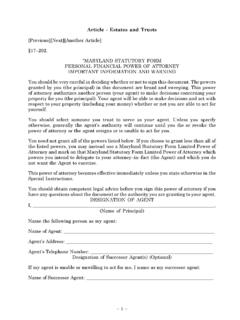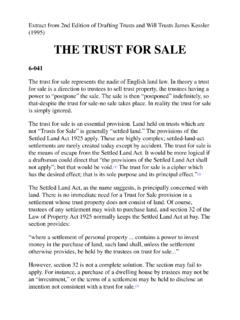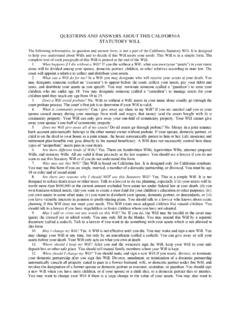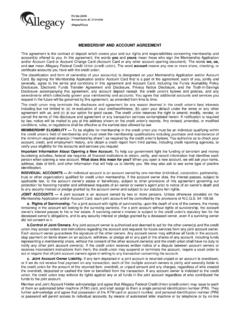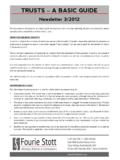Transcription of Employee Benefit Plans - Parties in Interest and ...
1 Employee Benefit Plans - Parties in Interest and prohibited transactions April 2011 Topix Primer Series Introduction The AICPA Employee Benefit Plan Audit Quality Center has developed this primer to provide a general understanding of Employee Benefit plan Parties in Interest and prohibited transactions under the Employee Retirement Income Security Act of 1974 (ERISA). This primer explains how a party in Interest under ERISA may differ from a related party as that term is defined by generally accepted accounting principles (GAAP). This primer discusses party in Interest transactions that are prohibited under ERISA and administrative actions of the Department of Labor (DOL), as well as statutory and administrative class and individual exemptions. This primer also discusses how exemptions may be requested, the reporting requirements for party in Interest and non-exempt transactions , applicable penalties imposed by ERISA or the Internal Revenue Code (IRC), and the Voluntary Fiduciary Correction (VFC) Program.
2 A list of references to additional resources is included at the end of this primer. Who is a Party in Interest ? ERISA defines a party in Interest . Employee Benefit Plans may engage in various types of business transactions with companies and individuals considered Parties in Interest under ERISA. A party in Interest is defined in ERISA section 3(14) to include the following: a. Any fiduciary (including, but not limited to, any administrator, officer, trustee, or custodian), counsel, or Employee of such Employee Benefit plan; b. A person providing services to such plan; c. An employer any of whose employees are covered by such plan; d. An Employee organization any of whose members are covered by such plan; e. An owner, direct or indirect, of 50 percent or more of (i) the combined voting power of all classes of stock entitled to vote or the total value of shares of all classes of stock of a corporation; (ii) the capital Interest or the profits Interest of a partnership, or (iii) the beneficial Interest of a trust or unincorporated enterprise, which is an employer or an Employee organization described in subparagraph (c) or (d); f.
3 A relative of any individual described in subparagraph (a), (b), (c), or (e); g. A corporation, partnership, or trust or estate of which (or in which) 50 percent or more of (i) the combined voting power of all classes of stock entitled to vote or the total value of shares of all classes of stock of such corporation, (ii) the capital Interest or profits Interest of such partnership, or (iii) the beneficial Interest of such trust or estate, is owned directly or indirectly, or held by persons described in subparagraph (a), (b), (c), (d), or (e); h. An Employee , officer, director (or an individual having powers or responsibilities similar to those of officers or directors), or a 10 percent or more shareholder directly or indirectly, of a person described in subparagraph (b), (c), (d), (e), or (g), or of the Employee Benefit plan; or i. A 10 percent or more (directly or indirectly in capital or profits) partner or joint venture of a person described in subparagraph (b), (c), (d), (e), or (g).
4 Note: The independent auditor of a plan s financial statements is a service provider to the plan and is considered a party in Interest . Other common Parties in Interest include plan sponsors, third party administrators, plan asset custodians, plan counsel, plan trustees, fund managers, and certain owners and/or shareholders of the plan sponsor. 2 of 6 Party in Interest vs. Related Party Parties in Interest and related Parties are not the same. ERISA s definition of a party in Interest is broader than a related party as that term is defined by GAAP. Parties in Interest will include all entities and individuals that provide services to the plan; however, these entities may not necessarily be related Parties . For example, the plan auditor, plan counsel and a non-affiliated third party administrator are considered Parties in Interest but typically are not considered related Parties under GAAP.
5 The term related Parties is defined in the glossary of the Financial Accounting Standards Board (FASB) Accounting Standards Codification (ASC) to include the following: Affiliates of the entity; Entities for which investments in their equity securities would be required, absent the election of the fair value option under GAAP, to be accounted for by the equity method by the investing entity; Trusts for the Benefit of employees, such as pension and profit-sharing trusts that are managed by or under the trusteeship of management; Principal owners of the entity and members of their immediate families; Management of the entity and members of their immediate families; Other Parties with which the entity may deal if one party controls or can significantly influence the management or operating policies of the other to the extent that one of the transacting Parties might be prevented from fully pursuing its own separate interests; Other Parties that can significantly influence the management or operating policies of the transacting Parties or that has an ownership Interest in one of the transacting Parties and can significantly influence the other to an extent that one or more of the transacting Parties might be prevented from pursuing its own separate interests.
6 prohibited transactions Certain transactions between the plan and Parties in Interest and the plan fiduciary may be prohibited . ERISA section 406(a) prohibits various types of transactions between a plan and Parties in Interest . ERISA states that a plan fiduciary shall not cause the plan to engage in a transaction if the plan fiduciary knows or should know that such transaction constitutes a direct or indirect Sale or exchange, or leasing, of any property; Lending of money or other extension of credit; Furnishing of goods, services, or facilities; Transfer to, or use by or for the Benefit of a party in Interest , of any assets of the plan; or Acquisition, on behalf of the plan, of any employer security or employer real property in violation of ERISA section 407. ERISA section 406(b) also prohibits certain transactions between the plan and the plan fiduciary.
7 A plan fiduciary is prohibited from using the plan s assets in their own Interest or act on both sides of a transaction involving a plan. Further, fiduciaries cannot receive money or any other consideration for their personal account from any party doing business with the plan related to that business. Note: One of the most common prohibited transactions involving the plan fiduciary is the failure to timely remit participant deferral contributions and loan repayments to the plan in accordance with DOL regulations. (See additional discussion under Reporting and Correcting Non-Exempt transactions ). 3 of 6 Penalties for prohibited transactions Monetary penalties can be assessed against Parties in Interest when they are involved in prohibited transactions with a plan. prohibited transactions may trigger civil monetary penalties under ERISA section 502(i) which provides the DOL authority to assess a penalty against a party in Interest of up to 5 percent of the amount involved for each year or part thereof during which a prohibited transaction continues.
8 This penalty does not apply to any plan subject to an excise tax under IRC section 4975(a). Section 4975 imposes a 15 percent excise tax against disqualified persons, which are substantially similar to ERISA Parties in Interest , who engage in prohibited transactions with qualified pension and profit sharing plan assets. A second tier tax of 100 percent of the amount involved is imposed if the transaction is not timely corrected. A prohibited transaction may also violate the exclusive Benefit rule in IRC section 401(a) potentially resulting in the plan trust losing its tax-exempt status. Therefore, disqualified persons engaged in prohibited transactions with qualified pension or profit-sharing Plans are subject to the IRC section 4975 excise tax, while Parties in Interest that are engaged in prohibited transactions with health and welfare Plans are subject to the ERISA section 502(i) civil penalty.
9 Exempt transactions Certain party in Interest transactions may be exempt from prohibited transaction rules. Certain transactions with Parties in Interest are exempt from the prohibited transaction rules, either because they are permitted by a statutory exemption in ERISA, covered under a class exemption issued by the DOL, or the DOL has granted an individual exemption. Statutory Exemptions in ERISA ERISA section 408(a) contains specific exemptions whereby Plans may engage in certain transactions with Parties in Interest otherwise prohibited by law. For example, the statutory exemptions include, among other exemptions, the following (with certain restrictions and limitations): Loans to plan participants or beneficiaries; The provision of services necessary for the operation of a plan for no more than reasonable compensation; Loans to Employee stock ownership Plans ; Deposits in certain financial institutions; Contracts for life insurance, health insurance, or annuities with one or more insurers; Providing of any ancillary service by a bank or similar financial institution; exercise of a privilege to convert securities; Transaction between a plan and a common or collective trust fund or pooled investment fund, or transaction between a plan and a pooled investment fund of an insurance company.
10 Distribution of the assets of the plan in accordance with the terms of the plan; Transfer made before January 1, 2014, of excess pension assets from a defined Benefit plan to a retiree health account in a qualified transfer; and Providing certain investment advice to a participant or beneficiary of an individual account plan that permits such participant or beneficiary to direct the investment of assets in their individual account. 4 of 6 Administrative Exemptions The DOL may grant administrative exemptions to an individual or a class of individuals allowing them to engage in a variety of transactions involving Employee Benefit Plans . DOL administrative exemptions are referred to as prohibited Transaction Exemptions (PTEs). Class exemptions are administrative "blanket" exemptions that permit a person to engage in a similar transaction or a series of similar transactions with a plan in accordance with the terms and conditions of the class exemption, without requiring the person to obtain an individual exemption from the DOL.

